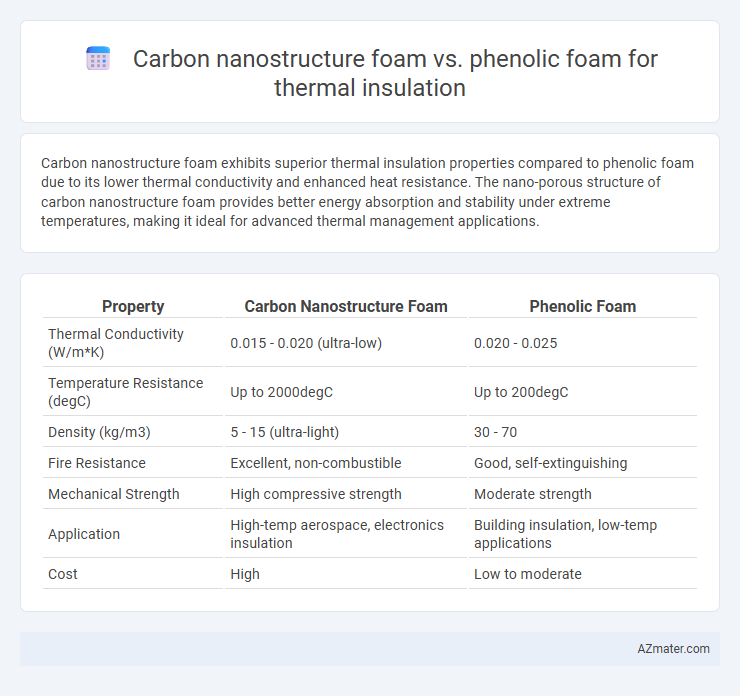Carbon nanostructure foam exhibits superior thermal insulation properties compared to phenolic foam due to its lower thermal conductivity and enhanced heat resistance. The nano-porous structure of carbon nanostructure foam provides better energy absorption and stability under extreme temperatures, making it ideal for advanced thermal management applications.
Table of Comparison
| Property | Carbon Nanostructure Foam | Phenolic Foam |
|---|---|---|
| Thermal Conductivity (W/m*K) | 0.015 - 0.020 (ultra-low) | 0.020 - 0.025 |
| Temperature Resistance (degC) | Up to 2000degC | Up to 200degC |
| Density (kg/m3) | 5 - 15 (ultra-light) | 30 - 70 |
| Fire Resistance | Excellent, non-combustible | Good, self-extinguishing |
| Mechanical Strength | High compressive strength | Moderate strength |
| Application | High-temp aerospace, electronics insulation | Building insulation, low-temp applications |
| Cost | High | Low to moderate |
Introduction to Advanced Thermal Insulation Materials
Carbon nanostructure foam exhibits superior thermal insulation properties compared to traditional phenolic foam due to its high porosity, low thermal conductivity, and exceptional mechanical strength at elevated temperatures. Phenolic foam, widely used for its cost-effectiveness and fire resistance, generally demonstrates higher thermal conductivity and lower durability under extreme thermal cycling. Advanced thermal insulation materials like carbon nanostructure foam enable enhanced energy efficiency in aerospace, construction, and industrial applications by combining lightweight morphology with robust thermal stability.
Overview of Carbon Nanostructure Foam
Carbon nanostructure foam offers superior thermal insulation properties compared to traditional phenolic foam due to its unique hierarchical porous architecture and high surface area, which significantly reduce heat transfer through conduction, convection, and radiation. Its exceptional thermal stability, lightweight nature, and resistance to chemical degradation make it ideal for high-temperature applications where phenolic foam may degrade or lose effectiveness. Advances in carbon nanostructure foam fabrication, including enhanced mechanical strength and tunable pore size distribution, further optimize its performance for aerospace, industrial, and energy-efficient building insulation.
Phenolic Foam: Properties and Applications
Phenolic foam offers superior thermal insulation due to its low thermal conductivity and excellent fire resistance, making it ideal for use in building panels, cold storage, and industrial insulation. Its closed-cell structure provides high compressive strength and dimensional stability under varying temperature conditions. Phenolic foam's lightweight nature combined with low smoke emission during combustion enhances safety and energy efficiency in commercial and residential construction.
Thermal Performance Comparison
Carbon nanostructure foam exhibits superior thermal insulation capabilities compared to phenolic foam, with thermal conductivity values often below 0.02 W/m*K, significantly lower than phenolic foam's typical range of 0.03 to 0.05 W/m*K. The highly porous and interconnected nanostructure in carbon foam effectively minimizes heat transfer through conduction, convection, and radiation, enhancing overall thermal resistance. Phenolic foam, while effective, tends to have higher thermal conductivity due to its cellular structure and polymer composition, making carbon nanostructure foam a preferable option for applications demanding ultra-low thermal conductivity.
Fire Resistance and Safety Considerations
Carbon nanostructure foam exhibits superior fire resistance compared to phenolic foam due to its high thermal stability and non-flammable carbon composition, reducing smoke toxicity and flame spread risk. Phenolic foam, while inherently fire-retardant with low smoke production, can release hazardous gases upon combustion, posing greater safety concerns in enclosed environments. Selection for thermal insulation prioritizes carbon nanostructure foam when enhanced fire safety and reduced toxic emissions are critical in high-risk applications.
Mechanical Strength and Durability
Carbon nanostructure foam exhibits superior mechanical strength and durability compared to phenolic foam, making it ideal for high-stress thermal insulation applications. Its unique nanostructured framework provides enhanced resistance to compression, impact, and thermal degradation. Phenolic foam, while effective as an insulator, generally lacks the mechanical robustness and long-term durability seen in carbon nanostructure foam, limiting its use in demanding environments.
Environmental Impact and Sustainability
Carbon nanostructure foam exhibits superior environmental benefits compared to phenolic foam due to its higher thermal insulation efficiency, which reduces energy consumption and carbon emissions over its lifecycle. Phenolic foam, while effective as an insulator, involves toxic additives and produces hazardous byproducts during manufacturing and disposal, raising environmental concerns. Sustainable applications increasingly favor carbon nanostructure foam for its recyclability, lower environmental toxicity, and potential for carbon capture integration.
Cost and Practical Scalability
Carbon nanostructure foam offers superior thermal insulation properties but comes with significantly higher production costs due to advanced synthesis methods and raw material expenses. Phenolic foam remains a cost-effective choice with established large-scale manufacturing processes, providing practical scalability for widespread thermal insulation applications. While carbon nanostructure foam excels in performance, phenolic foam is preferred for budget-sensitive projects requiring reliable mass production and installation.
Case Studies and Real-World Applications
Carbon nanostructure foam demonstrates superior thermal insulation properties in case studies involving aerospace and electronics cooling, showing thermal conductivity values as low as 0.02 W/m*K. Phenolic foam, widely adopted in building insulation and fire-resistant panels, offers robust flame retardancy with thermal conductivities typically around 0.03-0.04 W/m*K. Real-world applications highlight carbon nanostructure foam's lightweight advantage in high-performance sectors, whereas phenolic foam remains cost-effective and scalable for large-scale thermal insulation demands.
Future Trends in Insulation Technology
Carbon nanostructure foam offers superior thermal insulation performance due to its low thermal conductivity and high porosity compared to traditional phenolic foam. Research trends emphasize enhancing carbon nanostructure foams with hybrid nanomaterials to further reduce heat transfer and improve fire resistance. The future of insulation technology increasingly focuses on integrating carbon-based nanomaterials to achieve lightweight, eco-friendly, and ultra-efficient thermal barriers in aerospace and construction industries.

Infographic: Carbon nanostructure foam vs Phenolic foam for Thermal insulation
 azmater.com
azmater.com